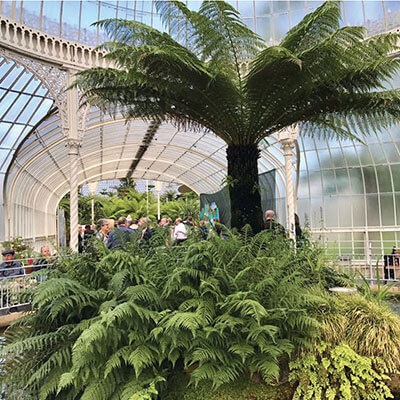
Stirling Castle sits atop Castle Hill and looks out over the town of Stirling in Scotland. The the Society of Architectural Historians invited local residents along for some of their tours. (VisitScotland/Kenny Lam)
Local tours aren’t usually the highlight of a conference, but for the Society of Architectural Historians (SAH), they’re an essential — and beloved — part of the program. At its 2017 Annual International Conference in Glasgow, Scotland, this past June, 7–11, SAH offered a staggering 26 local tours over the course of the five-day meeting. With access to seldom-seen areas and specialized tour guides, attendees took in castles, mansions, stained-glass windows, and other notable elements of Scottish architecture.
But it wasn’t only SAH members who had a chance to explore Glasgow’s built environment. In each city they descend on, SAH opens up its tours to the local community — and welcomes them to a half-day conference seminar, too. “I’ve been to loads of conferences where you sort of feel you could be anywhere and rarely see outside the hotel or conference center,” said Marina Moskowitz, Ph.D., a professor of cultural history at the University of Glasgow, who served as a local chair for the conference. “SAH really wants you to get a feel for not just the local buildings, but the community that lives among them.”
“Inviting the public in makes them part of the conversation,” noted Christopher Kirbabas, director of programs for SAH. “It’s one thing for our attendees to look at a building or a space, but when you include the people who live there — and hear how they use it, how they view it — it brings a whole other component to the experience.”
There’s plenty in it for the public, too. SAH scores access to locations that even local residents wouldn’t normally get to visit. This year, for example, a trip to Stirlingshire — a historic county just to the north of Glasgow — featured a stop at a private home called Cardross House. The owners agreed to open their doors to the group, which was led by a special guide from SAH: an independent scholar who is an expert on that particular house.
Another tour explored Cumbernauld, a “new town” from the 1960s that tumbled into neglect by the 1990s, with its town center partly demolished in 1999. The SAH group visited residential units and churches, all designed by private architects. “Getting access into buildings, some of which have been abandoned for a very long time,” Kirbabas said, “was really fascinating to me.” And any tour focused on Charles Rennie Mackintosh — a famous Scottish architect active in the late-19th and early-20th centuries — was “an immediate sellout,” including a visit to houses he designed in a wealthy suburb.

SAH attendees toured the Glasgow Botanic Gardens. (VIsit Scotland)
Assembling so many trips is a complicated process, but at each of its conference locations, SAH selects one or two members who live in the area to serve as local chairs. Those members develop tour ideas, hammer out plans, and secure entry to offbeat sites. “They’re experts in their field,” Kirbabas said, “and in their hometown.”
Early in the planning process, Moskowitz tapped the Glasgow Convention Bureau for tour ideas that had worked well at other conferences. “Our main aim in putting together the tour program was to be varied — hopefully having options that would suit everyone,” she said, “whether their interests are medieval architecture or cutting-edge modernism.”
Kirbabas ironed out the details, including box lunch orders, bus bookings, and registration costs. If tours don’t reach a break-even point, SAH cancels them; there were 33 trips originally scheduled for Glasgow conference, but seven were scrapped due to low registration numbers. SAH members have first dibs, but once the early-registration window closes, any remaining space is opened up to the general public. Kirbabas estimated that 20 locals joined the conference as tour-only participants this year — and other Glaswegians registered for the full meeting as well as the tours.
SAH has also started inviting locals to its Saturday-morning seminar. Every year since 2013, organizers choose a topic related to the host city and book local speakers to discuss it. For Glasgow, it was “Making and Re-Making Glasgow: Heritage and Sustainability,” and the discussion focused on balancing the city’s history with issues of environmental stewardship. SAH charged $10 for conference-goers and $20 for the general public. Kirbabas said that about 40 people showed up from the local community — in addition to 50 SAH attendees.
“I think it’s really great for the local community to realize that people all over the world value their hometown,” Moskowitz said. “Just as local participants gave our visitors important perspectives on architectural history from being ‘on the ground,’ at the same time, visiting delegates maybe remind our local community of the treasures on our doorstep that we might otherwise take for granted.”
